
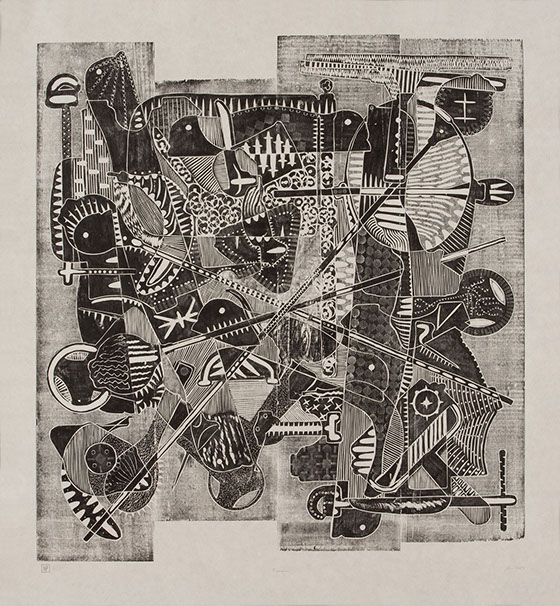
Bananas, 34.25" x 31.5", Edition of 8
Photo by David Kern, courtesy of Highpoint Center for Printmaking
Aaron Spangler: Luddite
@ Highpoint Editions
Aaron Spangler is best known as a sculptor, though he has been making frottage drawings for years. These rubbings, which the Minnesota-based artist creates by moving graphite over paper laid over a carved woodblock became the impetus for the series of ten woodblock prints which comprise Luddite. When I first encountered Aaron Spangler’s sculptures in his 2013 exhibition Homeschool at Horton Gallery in New York, I was struck by their sonorous, almost threatening quietness. In Homeschool it seemed that Spangler was settling in to a quieter, less didactic vision than in his more aggressive, militaristic sculptures which were shown in his 2010 exhibition Government Whore.
In this recent suite of large-scale woodcuts, Spangler exhibits his mastery (it is said one needs to clock 10,000 hours of labor into his or her trade to carry the title and he has been at it for nearly two decades) of carving, drawing and otherwise negotiating positive-negative spatial arrangements in this robust ensemble of prints. The immediate, in-your-face graphic quality of the medium is harnessed as a vehicle to deliver a series of prints which crackle with energy. Whether in sculpture or in these woodcuts, Spangler’s work extends out from the hermetic environ of the studio and into the communities to which he is connected: from the local timber industry to the printers at Highpoint. The scale of this series required that the prints be taken manually; a small team of printers, using only traditional barens and rubbing tools, spent countless hours burnishing the paper onto the carved basswood surface where the ink had been applied. The printers’ hands moved in figures of eight across the paper’s expanse. Did they peel back the edges of the paper to peek at the image while it was in mid-process? What did the printers talk about as they stood around the perimeter of this massive sheet of paper? Perhaps owing to Spangler’s stint in a band, it seems that the collective impulse, the labor-sharing ethos reverberates more than ever in these agitprop inspired images.

Constellation, 102.5" x 51", Edition of 3
Photo by David Kern, courtesy of Highpoint Center for Printmaking
Narrative is embedded within Spangler’s material a priori of his intervention upon it. He coaxes the story out from the network of the wood’s knots and pulpy flesh. The history of American industry, the cultural climate of America’s heartland and the tradition of woodcarving itself are a few examples of the tales which emerge out of Spangler’s process. One of the chief strengths in Spangler’s work is that despite their intensely worked-over surfaces, the artist knows to let the essential character of his material remain at the fore of our vision. Disembodied human arms have often appeared in Spangler’s carved imagery and these talismanic emblems of labor and making return throughout this current suite of prints. In the print Waiting in Line Spangler has used his own silhouette in a vertiginous image of claustrophobia. An upside-down shadow in the shape of the artist is densely filled in by an overall leaf-like pattern. He is encased in what appears to be a force field of electricity (neurosis?) while all around him, a jumbled scaffold of straight-edges holds the artist’s body in place.
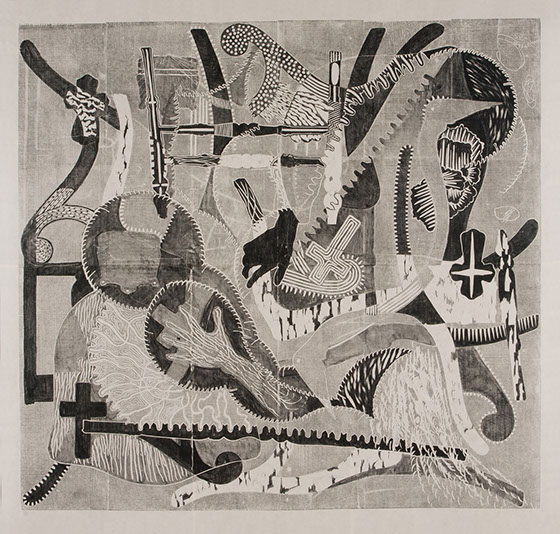
Fence Lines, 53.5" x 55.75", Edition of 5
Photo by David Kern, courtesy of Highpoint Center for Printmaking
Where block printing was once used as a means toward a high-impact, easy-to-reproduce image, as in propaganda or advertising, Spangler has subverted this history by creating densely layered images that unfold their message slowly over time. If we take Marshall McLuhan’s “the medium is the message” at face value then we are likely to gain more from Spangler’s work than if we rely on his iconography alone. These images demand our time and engagement in order to unpack the interlocking forms and complex textures. They insist that we attempt to access our “pre-internet” brain and remember that human experience is more than one-liners, “likes” and hyperbole. In Separatist two female figures emerge from the top of a tangle of flaccid machine guns, legs and vertebrae-like ribbons. The sphinx-like apparitions reach their hands out into the grainy-grey field as if grasping or
reaching for something just beyond the boundary of the image. The women are renderedmute, their gestures signal to the wood’s personality; it is as if the artist resuscitates the “dead” blocks of wood by carving, sanding and planing away its death mask and jump starting its anima through creative engagement. Spangler’s imagery itself is often a hybridized version of the idyllic American pastoral with a dark spectre that emerges in the form of semi-automatic weapons, contorted human hands or desolate bunkers overgrown by gnarly thickets. A handful of titles from this new series of woodcuts, alone, tell the story of a schizophrenic Americana where pathologized consumerism (Hoarder), the solipsism of self-help culture (Wholeness and Well Being) and border-paranoia (Fence Lines) all point to aspects of American life which are embedded in the cultural DNA of the Republic. Spangler’s images are the shadow side of the line “One nation, under God, indivisible, with Liberty and Justice for all.”
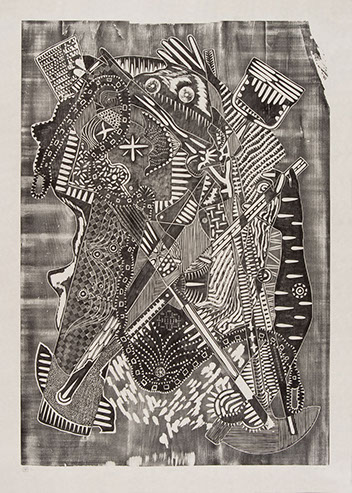
Hoarder, 48" x 34.25", Edition of 8
Photo by David Kern, courtesy of Highpoint Center for Printmaking
The role of the women in Separatist calls to mind a line from Robert Morris’s essay “Some Notes on the Phenomenology of Making.” Morris writes, “the body’s activity as it engages in manipulating various materials according to different processes has opened it to different possibilities for behavior. What the hand and arm motion can do in relation to surfaces is different from what hand, arm and body can do in relation to objects in three dimensions.”1 But Spangler throws a spider into the works of Morris’ observation. For one, the prints that are presented by Highpoint are massive by graphic-arts standards (several of the prints measure over one hundred inches high). When one considers the sheer physical labor that went in to carving the blocks of basswood and then printing the editions, how can one not think of these images as feats of physical endurance? By virtue of their scale and emphatically tactile quality, Spangler’s prints become like sculptures in themselves.
image. The women are rendered
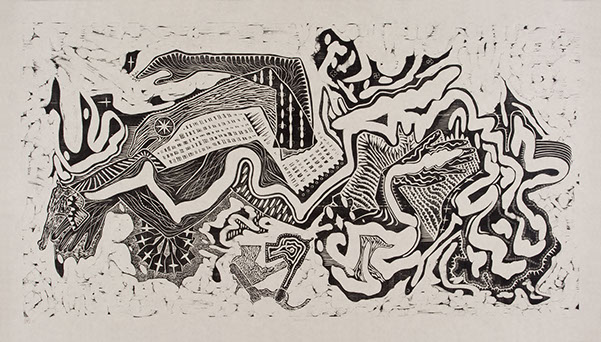
Reclining Arms, 33" x 58", Edition of 8
Photo by David Kern, courtesy of Highpoint Center for Printmaking
Traditionally, woodblock prints were made by applying ink to a carved surface, covering the surface with paper and then the image was transferred by rubbing the backside of the paper with a small handheld tool called a baren –a saucer-like disk. These days, a woodblock can also be printed by running the block through a press. But with Spangler’s monumental prints, all of the printing was done by hand using the baren method. Unlike the uniform and clean image that a press produces, this method allows the printer to adjust the saturation of the ink in specific areas by applying more, or less, pressure to portions of the image. In Spangler’s prints, the richness and subtlety of the method is an indispensable component in these images. Spangler’s process becomes a conceptual element in Luddite insofar as his work relates to rural life in the American Midwest: images of logging sites, self-sufficient homesteads, vast empty expanses of land. The shadow side of the idyll and idealism of the great American landscape and it inhabitants: militant radical separatism, poverty, and racism –undergirded by a deeply paranoid worldview (nurtured by the red white and blue ticker that runs ad infinitum at the bottom of one’s television screen) mar and pock the grainy surface of this Arcadian fantasy.
1 Robert Morris, Artforum, 1970
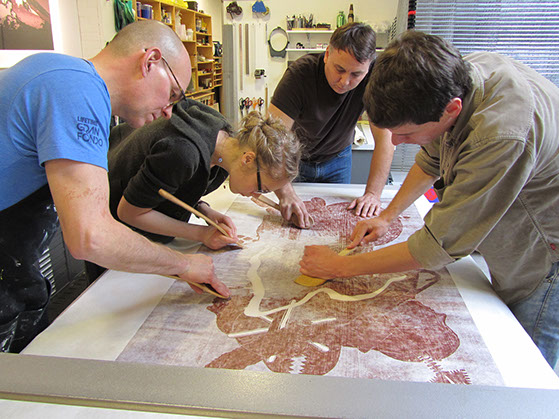
"Staff + artist": Highpoint Editions staff printing The Wall with artist Aaron Spangler
Photo by David Kern, courtesy of Highpoint Center for Printmaking
Luddite: New Prints by Aaron Spangler
Published by Highpoint Editions
October 10-November 15, 2014
From the website:
Highpoint Editions is delighted to present Luddite: New Prints by Aaron Spangler in its main galleries. The exhibition will feature ten handprinted woodcuts developed in collaboration between the artist and Highpoint’s professional printshop. Several of the prints are monumental in scale.
Primarily known for his sculptural work, Spangler is a virtuosic self-taught sculptor of wood. He carves intuitively, incorporating subjects from his daily life and surroundings to create compositions layered with political and social meaning. Themes and subject matter are drawn from his experiences and response to his natural surroundings and social observations in rural Minnesota: he is fascinated by ”rural chaos, personal paranoia, political anger, nature’s beauty and bounty, stoicism, severe religion, wellness, and spiritual bliss.”
Disclaimer: All views and opinions expressed are those of the authors and do not necessarily reflect the views of the editors, owner, advertisers, other writers or anyone else associated with PAINTING IS DEAD.
